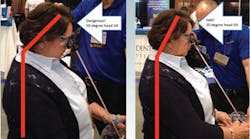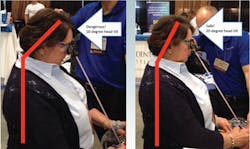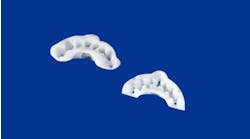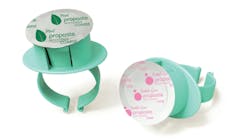BY ANNE NUGENT GUIGNON, RDH, MPH, CSP
Two decades ago, it was highly unusual for a dental hygienist to use magnification loupes. Now, many consider loupes the standard of care. About 12 years ago, a few schools around the country started encouraging students to purchase loupes. A few even made magnification mandatory. Through the years, many educators have learned that students using properly fitted magnification have better posture and provide higher quality clinical care.
In a relatively short time, many hygienists have adopted magnification, headlights, and saddle stools. New users are usually stunned with the improved visual images and quickly become addicted to using these devices. Many never consider what will happen when their loupes need repairing or an update. Suddenly, normally calm hygienists become panicky at the thought of working without magnification. While their angst is understandable, if loupes are such a valuable tool in your workplace, it simply makes sense to have a second pair.
--------------------------------------------------
Other articles by Guignon
- Have a seat: Ergonomic conversations turn to dental clinician seating
- The power of testimonials: Just remember that what works for a dental colleague may not work for you
- Dental germaphobics: When patients are not 'crazy'
--------------------------------------------------
When many of us started wearing loupes, our primary goal was to have an enlarged image. Improved posture was a secondary benefit, but as basic ergonomic principles are being applied to our workspaces, we need to rethink the goals of magnification. A number of years ago, Cindy Purdy, RDH, received the CEAS credential, a certification that recognizes her as an ergonomic assessment specialist. As we discussed the challenges many of us face in delivering quality care, she pointed out that two basic ergonomic principles come into play-fit the job or tool to the person, and achieve and maintain a neutral body posture. Sadly, even those who have adopted devices such as magnification loupes or saddle stools may still be violating both principles.
Cindy encourages you to remember what you learned in your anatomy and physiology course. The skeletal system is designed to support healthy body postures. Many dental health-care workers use their muscles instead of their bones throughout the workday. This leads to unnecessary fatigue and increases the risk for developing a musculoskeletal disorder or injury.
Look around at your colleagues or have someone take a photo of you in the clinical setting. When loupes are properly fitted, the user's neck will have an upright, neutral posture. If the neck has a forward, bent posture, the user is getting a magnified image, but the neck, back, and shoulder muscles are getting a painful workout. Remember, loupes are a tool and the goal is to adapt the tool to the user. Properly adjusted magnification loupes allow your spine to support your neck.
There are many reasons why loupes are not properly adjusted. First, in an effort to test the waters with very little financial risk, some clinicians try using another person's loupes. Others order inexpensive products online with incorrect measurements, or even pick a product from a reseller on eBay. There is a high probability that magnification from resources like these will not fit your face or will have a problem with the working distance or declination angle.
Custom-fitted quality magnification loupes have never been inexpensive. They're made with oculars that have high-quality optical glass, and frames that can be personally adjusted to the user's face. The two most critical features of any magnification system are working distance and declination angle. Much more is now known about these two measurements. Due to manufacturing advancements, several manufacturers can now create custom through-the-lens loupes with much steeper declination angles than in years past. If your magnification is old or your neck is bent, it may be time to reevaluate your system.
Working distance is measured from the front of the eye to a mid-depth point in a patient's mouth. The first molar is a perfect reference point. When this measurement is taken, it is important to keep your head erect rather than letting your muscle memory take over. True magnification loupes feature depth of field, which allows the user to keep his or her head still while visualizing the entire oral cavity. Reading glasses are created for viewing a fixed plane, like a book. Readers are not appropriate substitutes for real loupes.
The declination angle also plays a critical role in maintaining a neutral neck posture. Facial geometry and the size of your head play a critical role in frame selection. Select a frame that fits your face, not the most current fashion statement. Those with deep-set eyes, prominent cheekbones, or a high nose bridge will require a much steeper declination angle. Frames with carrier lenses that are small from top to bottom can't support a deep declination angle. The oculars need to be mounted so the user can look over the top of the oculars with his or her head in a stationary position.
Through-the-lens (TTL) systems are designed with the oculars placed into the carrier lens, creating a fixed declination angle. The type of TTL frame is important. Titanium and carbon composite frames are adjustable. Small adjustments to the temples, frame front, or nose pad can increase the declination angle slightly. Plastic frames are lightweight but generally cannot be adjusted.
TTL systems are still the most popular. Flip-up loupes have improved dramatically over the last decade. Years ago the oculars were heavy and the hinges were not very sophisticated. Several companies now offer hinge systems where the user can create his or her own custom declination, and where the ocular is positioned vertically with respect to the frame.
Many ergonomists recommend sit/stand positioning because this allows the spine to maintain healthy curvatures that support the torso. Saddle seats are designed with these principles in mind. In addition to reducing muscular stress, clinicians are able to sit up higher and get closer to the patient. Saddle seating can be used successfully by clinicians of all heights, but short clinicians benefit greatly from sitting higher. Sitting closer reduces unnecessary reaching. Sitting higher reduces stress to the shoulder and back muscles by creating a neutral seating posture. The patient's head can be positioned so the clinician's arms are kept parallel to the floor and closer to the body.
Since sit/stand positioning brings the clinician closer to the workspace, the declination angle may have to be increased to account for the change in spatial dynamics. This doesn't mean that using a saddle is bad. It's just a case of simple geometry. Remember, everything needs to be in balance to support your musculoskeletal health.
Just as it is important to never go scuba diving or snorkeling alone, learn to employ the buddy system when getting measured for loupes or a saddle. Have a friend take photos of your neck and torso postures. Then take some shots using properly adjusted equipment. It's a real eye opener to see the postural changes that can occur. When Cindy was being fitted for a new pair of loupes, she asked me to snap some photos on my smart phone. It was a real eye opener to see what a a one inch difference in neck position could make in overall comfort.
If you already have loupes or a saddle, but you're still not comfortable, it's also a good idea to take some photos. It's shocking to see clinicians with loupes who still have poor head postures and distressing to hear from hygienists who still suffer neck pain while wearing loupes. Just like magnification that doesn't fit, some people use a saddle that's not designed for their torso or is poorly adjusted. Equipment that does not fit properly adds to musculoskeletal stress and increases the risk for a workplace injury.
Loupes, lights, and saddles are not magic bullets. They're tools, and the tools must be appropriate and fit the user, not the other way around. Good decisions about your workspace ergonomics will go a long way to improving your comfort zone. RDH
Using the buddy system to get the right measurements
It is virtually impossible to practice without a slight forward head tilt. But your head position should never exceed 20 degrees from neutral. Many people use loupes that violate this important ergonomic principle.
These photos clearly demonstrate that even a slight tilt of the neck can create a very dangerous head posture. A 50-degree head tilt means the muscles are supporting the weight of the head, resulting in unnecessary fatigue in the neck, shoulders, and the mid and upper back.
Don't skip the all-important step of getting precise measurements. The right measurements will make your magnification loupes a posture enhancer and a joy to use.
ANNE NUGENT GUIGNON, RDH, MPH, CSP, provides popular programs, including topics on biofilms, power driven scaling, ergonomics, hypersensitivity, and remineralization. Recipient of the 2004 Mentor of the Year Award and the 2009 ADHA Irene Newman Award, Anne has practiced clinical dental hygiene in Houston since 1971, and can be contacted at [email protected].







